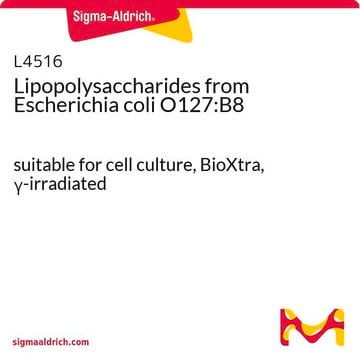L5543
Lipopolysaccharides from Escherichia coli O26:B6
Ready Made solution, 1 mg/mL, 0.2 μm filtered
Sinonimo/i:
LPS
About This Item
Prodotti consigliati
Origine biologica
Escherichia coli (O26:B6)
Livello qualitativo
Sterilità
0.2 μm filtered
Forma fisica
aqueous solution
Concentrazione
1 mg/mL
Colore
colorless to faint yellow
Solubilità
water: soluble
Condizioni di spedizione
wet ice
Temperatura di conservazione
2-8°C
Cerchi prodotti simili? Visita Guida al confronto tra prodotti
Descrizione generale
Applicazioni
Azioni biochim/fisiol
Nota sulla preparazione
Altre note
Prodotti correlati
Codice della classe di stoccaggio
12 - Non Combustible Liquids
Classe di pericolosità dell'acqua (WGK)
WGK 1
Punto d’infiammabilità (°F)
Not applicable
Punto d’infiammabilità (°C)
Not applicable
Dispositivi di protezione individuale
Eyeshields, Gloves, multi-purpose combination respirator cartridge (US)
Certificati d'analisi (COA)
Cerca il Certificati d'analisi (COA) digitando il numero di lotto/batch corrispondente. I numeri di lotto o di batch sono stampati sull'etichetta dei prodotti dopo la parola ‘Lotto’ o ‘Batch’.
Possiedi già questo prodotto?
I documenti relativi ai prodotti acquistati recentemente sono disponibili nell’Archivio dei documenti.
I clienti hanno visto anche
Articoli
Explore the structure, function, and diverse applications of Lipopolysaccharides. Discover their role in bacteria, serological specificity, and research potential.
Contenuto correlato
Lipopolysaccharide (LPS) is a major component of Gram-negative bacteria, important for microbiological research.
Il team dei nostri ricercatori vanta grande esperienza in tutte le aree della ricerca quali Life Science, scienza dei materiali, sintesi chimica, cromatografia, discipline analitiche, ecc..
Contatta l'Assistenza Tecnica.





